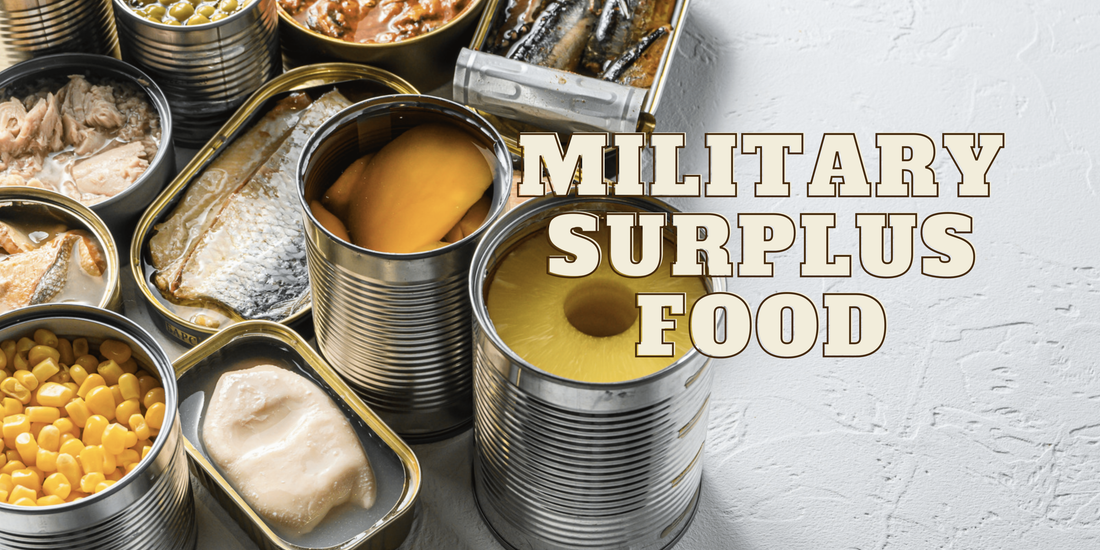- Where does Military Surplus come from?
The term "military surplus foods" refers to foods that were produced and packaged for the military originally. It is now possible for the general public to purchase these products through surplus stores or online retailers. Due to their compact, durable, and lightweight nature, these foods are often easy to transport during emergencies or military operations.
Military surplus foods include brand like MREs (Meals, Ready-to-Eat), Future Essentials, Yoders Meat, and XMRE is the new generation of ready to eat meal.
- Why Military Surplus Food is important
Surplus food has several unique benefits few of them are :-
- The shelf life of military surplus foods are several months to several years. Defense sector is using it for several years and through various preservation methods such as vacuum sealing, freeze drying, or canning they store it
- The Military Food Supply is lightweight and easy to transport.
- Surplus foods are designed to be provide a balance of carbohydrates, proteins, and fats to maintain energy levels.
- Ease of preparation: military surplus foods are often designed to be easy to prepare and require minimal equipment or preparation time.
- Durability: military surplus foods are designed in toughest envirionmental conditions where conventional foods might spoil or be damaged.
- What are the Different Types of Military Surplus Foods?
There are several types of military surplus foods available on the market. Here are some of the most common types:
- MREs (meals, ready-to-eat): Two types of MREs are available, MREs and XMREs. These meals come in individual pouches that are completely self-contained. These meals often contain main dishes, sides, snacks and desserts and do not require a stove or other cooking equipment.
- Energy bars are compact, lightweight and designed to provide quick energy. We currently stock Mayday bars, which come in a variety of flavors and full with vitamins and minerals.
- Military Surplus canned goods and boxes often include canned meats, vegetables and fruits. Our Military Surplus collection provides convenient nutrition and is designed to last.
- Freeze-Dried Foods: Freeze-dried foods are dehydrated and then vacuum sealed to remove moisture. They are lightweight, compact and have a long shelf life. They can contain a wide range of foods, from fruits and vegetables to meats and main dishes.
- In emergencies, our Military Surplus Food Storage collection provides a long-lasting food source. Dried fruits and vegetables, protein bars and energy gels are often included in these snacks.
Overall, Military Surplus foods come in a variety of types and flavors that can be used for a variety of situations, from camping and backpacking to emergency preparedness and survival assistance.
- How to use it:-
Here are some general tips for using military surplus foods:
- It is important to properly store surplus military foods to protect their freshness and safety. Store them in a cool, dry place away from direct sunlight and moisture.
- Prepare properly: Depending on the type of food, preparation instructions may vary. Some military surplus meals, such as MREs, can be eaten right out of the package, while others may need to be heated or mixed with water.
- Check for damage: Check the packaging for signs of damage, such as punctures or tears, before consuming food from military stocks. In cae of any issue you can contact us on customerservice@safecastle.com
- Rotate your stock: rotate your stock regularly by using up the oldest items first and replacing them with newer ones.
Overall, surplus food can be a convenient and cost-effective way to meet your basic food needs in a variety of situations.
FAQs
- What are Military Surplus packs called?
Military Surplus food is packed food like XMREs, MRE and Military Surplus canned food with #10 can size and 2.5 can size.
- Is Military Surplus Worth It
Whether military surplus food is worth it or not depends on a variety of factors like Good quality, Better cost, all-time availability and longer shelf life.
- How Much Surplus Food Supply Is In The United States
The US government maintains strategic food reserves in case of emergencies, such as natural disasters or national security threats.


